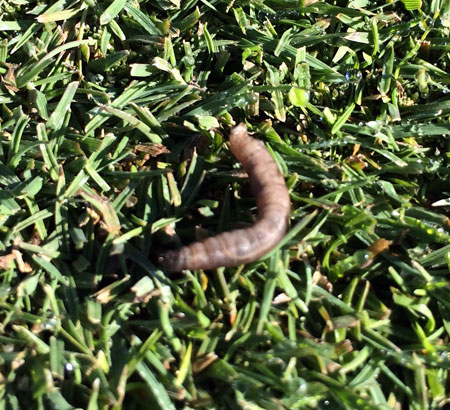So the moth I posted in the last blog post is actually the Black Cutworm Moth. And sure enough - I tracked down some grass sod - so I could dig deep into the grass roots. I replaced the brown thatch spots with the new grass sod and - on the EDGE of the dead grass - going into the new grass - I found TWO caterpillars. The first one I lost - because I was so excited to show the land owner what was eating his grass. The second one - he was there when I discovered it and he was surprised also.
Obviously you can't see it in the photo but there's even the black spots uneven in size - along the side. Are they paired? It's greasy - hmm. It's the same colors. It must be some variation of the species.
http://www.oisat.org/pests/insect_pests/caterpillars_grubs/cutworm/general_information.html
ok here we go:
https://agfax.com/2021/05/06/minnesota-be-on-lookout-for-black-cutworms/
Yep one of those is definitely close enough.
I had already ID'd the moth as a Black Cutworm Moth - so now the caterpillar synches it!
https://blog-crop-news.extension.umn.edu/2021/05/pest-alert-black-cutworm.html
yep definitely a black cutworm caterpillar!
Amazing.
Symptoms: Cutworms shelter in underground burrows during the day and emerge at night to feed at the base of grass, biting stems completely off. Both the burrows and sheared-off grasses are visible on closer examination. Short grasses are often hit hardest, with damage leading to dead spots in the yard.
https://extension.umn.edu/yard-and-garden-insects/cutworms
different varieties
https://extension.umn.edu/corn-pest-management/black-cutworm#black-cutworm-migration--1185160
Sprinkle cornmeal around your garden. Cutworms love it but can't digest it. Some will die from overeating the treat. ... It dries on the cutworms' bodies and immobilizes them.
Wow -
There are approximately 20,000 kinds of cutworms, including tunneling, subterranean, and climbing species (such as the armyworm), but the surface feeders are the most common. These spend two summers as destructive larvae (overwintering in the soil) before they mature into harmless moths.
Wireworms are 1/2 to 11/2 inches long, usually hard and tan or brown, but sometimes soft and white. They prefer grass, but will feed on many garden plants and are frequently pests of vegetable gardens. Wireworms bore into roots and underground stems of grass plants, causing the tops to wilt and die.
OK NOW it makes sense - I put out a fermenting sweet trap last night and there were two black bugs in it - they must have been the Click Beetles!
They look like ants but not flying ants - so I was confused. But click beetles can fly.





No comments:
Post a Comment